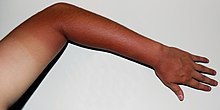News
07/20/2023**Moderate exposure to direct sunlight contributes to the production of melanin and vitamin D by the body.


Moderate exposure to direct sunlight contributes to the production of melanin and vitamin D by the body.
Excessive exposure[edit]
Excessive exposure to ultraviolet rays has negative health effects, including sunburn. Some people tan or sunburn more easily than others. This may be the result of different skin types and natural skin color, and these may be a result of genetics.[1][2] The term "tanning" has a cultural origin, arising from the color tan. Its origin lies in the Western culture of Europe when it became fashionable for young women to seek a less pale complexion (see Cultural history below).
Long-term[edit]

Excessive exposure may in the long-term increase the risk of skin cancer,[3] as well as depressed immune system function and accelerated aging of the skin.[4]
Tanning process[edit]
Melanin is a natural pigment produced by cells called melanocytes in a process called melanogenesis. Melanocytes produce two types of melanin: pheomelanin (red) and eumelanin (very dark brown). Melanin protects the body by absorbing ultraviolet radiation. Excessive UV radiation causes sunburn along with other direct and indirect DNA damage to the skin, and the body naturally combats and seeks to repair the damage and protect the skin by creating and releasing further melanin into the skin's cells. With the production of the melanin, the skin color darkens. The tanning process can be triggered by natural sunlight or by artificial UV radiation, which can be delivered in frequencies of UVA, UVB, or a combination of both.[5] The intensity is commonly measured by the UV Index.[6]

There are two different mechanisms involved in the production of a tan by UV exposure: Firstly, UVA radiation creates oxidative stress, which in turn oxidizes existing melanin and leads to rapid darkening of the melanin. UVA may also cause melanin to be redistributed (released from melanocytes where it is already stored), but its total quantity is unchanged. Skin darkening from UVA exposure does not lead to significantly increased production of melanin or protection against sunburn.[7] In the second process, triggered primarily by UVB, there is an increase in production of melanin (melanogenesis),[8] which is the body's reaction to direct DNA photodamage (formation of pyrimidine dimers) from UV radiation.[9] Melanogenesis leads to delayed tanning, and typically becomes visible two or three days after exposure.[8] The tan that is created by increased melanogenesis typically lasts for a few weeks or months, much longer than the tan that is caused by oxidation of existing melanin, and is also actually protective against UV skin damage and sunburn, rather than simply cosmetic. Typically, it can provide a modest Sun Protection Factor (SPF) of 3, meaning that tanned skin would tolerate up to 3 times the UV exposure as pale skin.[10] However, in order to cause true melanogenesis-tanning by means of UV exposure, some direct DNA photodamage must first be produced, and this requires UVB exposure (as present in natural sunlight, or sunlamps that produce UVB).[citation needed] The ultraviolet frequencies responsible for tanning are often divided into the UVA and UVB ranges.
UVA[edit]
Ultraviolet A (UVA) radiation is in the wavelength range 320 to 400 nm.[11] It is present more uniformly throughout the day, and throughout the year, than UVB. Most UVA is not blocked by the atmosphere's ozone layer. UVA causes the release of existing melanin from the melanocytes to combine with oxygen (oxidize) to create the actual tan color in the skin.[citation needed] UVA is blocked less than UVB by many sunscreens, but is blocked to some degree by clothing. UVA is known both to cause DNA damage and to be carcinogenic. However, it operates not by inducing direct DNA damage, but by producing reactive oxygen species which damage DNA indirectly. UVA (see above) induces a cosmetic tan but little extra melanin protection against sun damage, sun burn, or cancer.[citation needed]
UVB[edit]
Ultraviolet B (UVB) radiation is in the wavelength range 280 to 320 nm. Much of this band is blocked by the Earth's ozone layer, but some penetrates. UVB:
triggers the formation of CPD-DNA damage (direct DNA damage), which in turn induces an increased melanin production.[9]
is more likely to cause a sunburn than UVA as a result of overexposure. The mechanism for sunburn and increased melanogenesis is identical.[12] Both are caused by the direct DNA damage (formation of CPDs).
produces Vitamin D in human skin.
is reduced by virtually all sunscreens in accordance with their SPF.
is thought, but not proven, to cause the formation of moles and some types of skin cancer.
causes skin aging (but at a slower rate than UVA).[citation needed]
stimulates the production of new melanin, which leads to an increase in the dark-colored pigment within a few days.[13]
Tanning behavior of different skin colors[edit]
A person's natural skin color affects their reaction to exposure to sunlight. An individual's natural skin color can vary from a dark brown to a nearly colorless pigmentation, which may appear white. In 1975, Harvard dermatologist Thomas B. Fitzpatrick devised the Fitzpatrick scale which described the common tanning behavior of various skin types, as follows:[14][15]
| Type | Also called | Sunburning | Tanning behavior | von Luschan scale |
|---|---|---|---|---|
| I | Very light or pale | Often | Occasionally | 1–5 |
| II | Light or light-skinned | Usually | Sometimes | 6–10 |
| III | Light intermediate | Rarely | Usually | 11–15 |
| IV | Dark intermediate | Rarely | Often | 16–21 |
| V | Dark or "brown" type | No | Sometimes darkens | 22–28 |
| VI | Very dark or "black" type | No | Naturally black-brown skin | 29–36 |
Sunburn peeling

The most common risk of exposure to ultraviolet radiation is sunburn, the speed and severity of which vary among individuals. This can be alleviated at least to some extent by the prior application of a suitable-strength sunscreen, which will also hinder the tanning process due to the blocking of UV light. Overexposure to ultraviolet radiation is known to cause skin cancer,[16] make skin age and wrinkle faster,[17] mutate DNA,[18] and impair the immune system.[19] Frequent tanning bed use triples the risk of developing melanoma, the deadliest form of skin cancer, according to a 2010 study. The study suggests that the melanoma risk is linked more closely to total exposure than it is to the age at which an individual first uses a tanning bed.[20] The International Agency for Research on Cancer places the use of tanning beds in the highest cancer risk category, describing them as carcinogenic to humans even if used as recommended.[citation needed] Frequent tanning also has behavioural reinforcing effects,[21] following UVA radiation epidermal keratinocytes synthesize POMC inducing the production of β-Endorphins which are opioid agonists. An opioid blockade will also then cause withdrawal signs after habitual UV exposure leading to many tanners meeting the DSM-IV criteria for addiction.[22] Several organizations, such as the World Health Organization (WHO), the American Cancer Society and the US Surgeon General have issued guidelines warning about sun tanning and UV radiation exposure, either from the sun or from indoor tanning.[23][24][25] Production of vitamin D is essential for human health. Moderate exposure (avoiding sunburn) to UV radiation provides benefits such as increased vitamin D, as well as other possible benefits that are still being studied.[26] Several tanning activators have used different forms of psoralen, which are known to be photocarcinogenic.[27][28][29] Health authorities have banned psoralen since July 1996.[30]
Cultural history[edit]
See also: Social status, colorism and racism

Tanning has gone in and out of fashion. In the United States and Western Europe before the 1920s, tanned skin was associated with the lower classes because they worked outdoors and were exposed to the sunlight. Women in particular went to great lengths to preserve pale skin, as a sign of their "refinement".[31] Women's outdoor clothing styles were tailored to protect them against sunlight exposure, with full-length sleeves, and sunbonnets and other large hats, headscarves, and parasols shielding the head. Lead-[32] and arsenic-based cosmetics were used to artificially whiten the skin. The preference for fair skin continued until the end of the Victorian era.[33] By the early 20th century, the therapeutic benefits of sunlight began to be recognized.[34] In 1903, Niels Finsen was awarded the Nobel Prize in Medicine for his “Finsen Light Therapy”.[35] The therapy was a cure for diseases such as lupus vulgaris and rickets. Vitamin D deficiency was found to be a cause of rickets, and exposure to sunlight would allow vitamin D to be produced in a person. Therefore, sunlight exposure was a remedy to curing several diseases, especially rickets. In 1910 a scientific expedition went to the island of Tenerife to test the wider health benefits of "heliotherapy",[36] and by 1913 "sunbathing" was referred to as a desirable activity for the leisured class.[37] Shortly thereafter, in the 1920s, fashion-designer <a href="https://en.
RELATED NEWS
- 07/28/2023**Tanning behavior of different skin colors 2023-07-28
- 07/272023**Sun tanning or tanning 2023-07-27
- 07/22/2023**Tanning process 2023-07-22
- 07/16/2023**Cultural history 2023-07-16
CATEGORIES
LATEST NEWS
CONTACT US
Contact: July
Phone: 008615093094434
E-mail: July@zzthoth.com
Whatsapp:008615093094434
Add: 507, Floor 15, Building B, Shenglong Youyicheng, Changchun Road, Science and Technology Development Zone, Zhengzhou, Henan 450000
